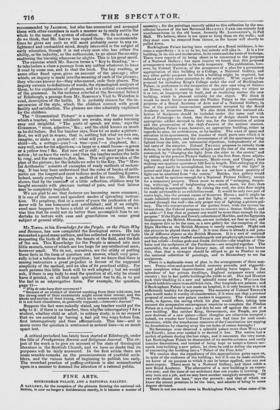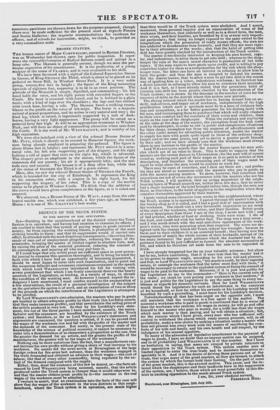FINE ARTS.
BUCKINGHAM PALACE, AND A NATIONAL GALLERY.
A GALLERY, for the reception of the pictures forming the national col- lection, is now no longer a desideratum merely, it is become a matter of necessity ; for the paintings recently added to this collection by the mu. nificent bequest of the late Reverend LIOLIVELL CARR can scarcely find warehouse-room in the old house, formerly Mr. ANGERSTEIN'S, in Pall Mall. We believe, there is not space to hang them on the walls ; and they must soon be removed from thence, as the house will shortly be pulled down. Buckingham Palace having been rejected as a Royal residence, is be- come a superfluity : it is to be let, but nobody will take it. It is a low building, in its site and its elevation, in its rooms and the taste of its design. There were reports of its being about to be converted to the purposes of a National Gallery ; but upon inquiry we found that this proposed arrangement was intended to be only temporary. The publication, how. ever, by Colonel TRENCH., of the prospectus of a plan for a permanent appropriation of this building to a College, a National Gallery, and any other public purposes for which a building might be required, has induced us to give some attention to the subject. With regard to the proposal for including King's College under the roof of Buckingham Palace, in preference to the occupation of the new east wing of Somer. set House, which is erecting for this especial purpose, we object to it in tau, as inappropriate in itself, and as rendering useless the new building, which is planned suitably for the object. We think it would be much better to devote the Pimlico Palace to the combined purposes of a Royal Academy of Arts and of a National Gallery, in lieu of the present inconvenient apartments occupied by the Royal Academy in Somerset House. We also think that the national col. lection of Sculpture should be included under the same roof with that of Paintings—in short, that the arts of design should have an appropriate edifice devoted to their use, for the instruction of artists and the preservation of the chefs d'oeuvres of the ancient masters. Buckingham Palace is not, however, an appropriate building, either as regards its plan, its architecture, or its locality. The want of space and elevation in its apartments, the number of small parts into which it is frittered, its dampness, and the circumstance of all the apartments being lighted from the side, are substantial objections, independently of the had taste of the exterior. Colonel TRENCH proposes to remedy these defects, in so far as the admission of light and the size of the rooms are concerned, by "changing the light from the sides to the centre," and by adding to the present Picture Gallery on the first floor, three adjoin. ing rooms, and the intended Armoury, Music-room, and Chapel ; thus making one spacious apartment 526 feet in length. This enlarging of the gallery may easily be accomplished, but the C6 change of the light" is sooner said than done ; for we do not see how a sufficient quantity of light can be admitted from " the centre." Besides, this gallery would not in itself be spacious enough for a National Picture Gallery, except for a temporary purpose. There must be more of "enlarging, deepen- ing, widening," and of heightening also,—much more, we fear, than the building is susceptible of. By raising the roof, the attic floor might be made serviceable as an exhibition-room. It would be only two pair of stairs high, like the present rooms of Somerset House ; and it might be made infinitely more spacioui ; and the light, of course, would be ad- mitted through the roof—the only proper way of lighting a picture gal- lery. The two conservatories of the garden front, with the terrace be- tween them the Colonel proposes to convert into a Statue Gallery, and he adds—"I fear that at present one would be more than enough for the purpose." If the Elgin andTownl y collections of Marbles, and the Egyptian Sculptures at the British Museum, are not included, we fear so too; and we suppose this to be the case, as a new gallery for the reception of the Elgin Marbles at the British Museum is nearly completed. Might not- the pictures be placed there also ? It is true there is already a sad juns• ble of different objects at the British Museum. It is a sort of national curiosity-shop, where stuffed cameleopards and porphyrysphynxes—birds and bas reliefs—Indian gods and Greek divinities—the trophies of Ota- heite and the sculptures of the Parthenon—are mingled together. The naturalist, the artist, and the literary man, all meet there ; but better this, than that a stranger should be obliged to go to Pimlico to see the national collection of paintings, and to Bloomsbury to see the sculptures.
There is a deplorable want of plan in the arrangement of these mat- ters. Penny-wise-and-pound-foolish economy prevails, and niggardli- ness completes what improvidence and jobbing have begun. In the splendour of her private dwellings, England surpasses every other country ; but in her public buildings she yields to all. D.sy and Meerut pack their blacking in a new and spleudid stone edifice ; WILLIAM the Fourth holds hi s court in an old brick ruin. Our hospitals are palaces ; and if Buckingham Palace is not made an hospital, it is only because it is not sufficiently healthy for the purpose. The economy of Colonel Tansrca'S plan would make it worthy of consideration, if it were not that a pendant proposal of another new palace renders it nugatory. The Colonel sets forth, in figures, the saving which his plan would effect, taking into account the prospective extravagance requisite to complete the Pimlico Palace as a royal habitation ; and this he sets off against the cost of a new building. But neither King, Government, nor People, are just now desirous of a new palace—their thoughts are otherwise occupied : indeed, we wonder how Colonel TRENCH can find time for such consi- derations, while the treacherous restorers of the Constitution are sapping its foundations by clearing away the rat-holes of rotten boroughs ! No Sovereign ever deserved a splendid palace more than WILLIAM' the Fourth; none ever needed it or desired it less. The nation had a surfeit of palaces during the.last reign, and it nauseates the very name. Let Buckingham Palace be dismantled of its marble columns and costly interior decorations, and instead of being kept to tempt a future mo- narch into building a new palace, let them be sold to defray the expense. of converting the building into a " Palace of the Fine Arts." We confess that the expediency of this appropriation gains upon us,. in spite of the unfitness of the building; but if it can be made suitable, we know of no purpose to which it can be better applied, nor any one more urgent. There must be a National Gallery, and there needs a new Royal Academy. The alternative of a new building is an expen- sive one; and the taste of our architects does not render it inviting. It may turn out a job, and we may have another unsightly structure. "Of two evils choose the least," says the proverb : and that of which we know the extent promises to be the least, and admits of being in some degree obviated.
There is not too much room in Buckingham Palace, when some of its numerous partitions are thrown down for the purposes proposed, though there may be made sufficient for the present need as regards Picture and Statue Galleries : the requisite accommodations for residence for officers, and of schools for instruction, might, we think, be provided on a very commodious scale.



























 Previous page
Previous page